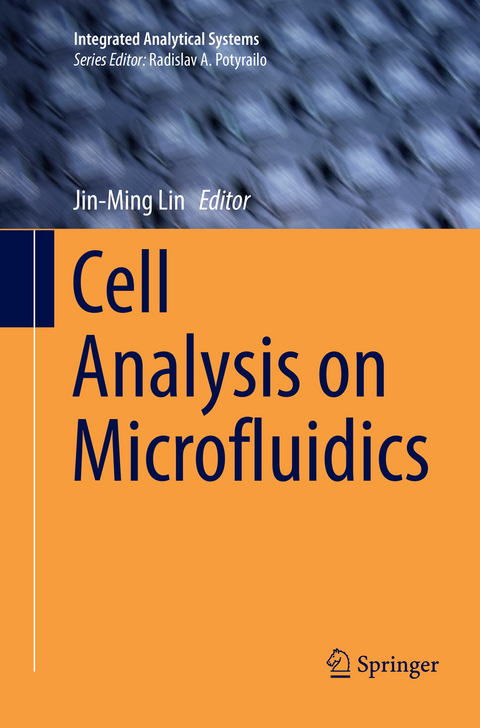
Cell Analysis on Microfluidics
Springer Verlag, Singapore
978-981-13-5386-4 (ISBN)
Professor Jin-Ming Lin was born in 1963. He received his Bachelor of Science degree at Fuzhou University in 1984 and his PhD in analytical chemistry at Tokyo Metropolitan University, Japan in 1997. He studied and worked at Showa University, Japan and Tokyo Metropolitan University from 1992 to 2002. He was a professor at the Research Center for Eco-Environmental Sciences, Chinese Academy of Sciences from 2002 to 2004, and has been a professor at Tsinghua University, China since 2004 and was selected as Cheung Kung Scholars Professor of Ministry of Education, China at 2008. He is a Fellow of Royal Chemical Society. He is a general secretary and deputy chair of Mass Spectrometry Committee, Chinese Chemical Society, a vice president Chinese Society of Mass Spectrometry, and a member of the council of the Chinese Society for Chromatography Science. He received several awards for his contributions in chemiluminescence and separation science: Outstanding Young Chemist Award (Chinese Chemical Society, 1992), Young Analyst Award for Flow Injection Analysis (Flow Injection Section, Japan Society of Analytical Chemistry, 2000), Kanton New Century Award (Japan Society of Analytical Chemistry, 2001), National Science Fund for Distinguished Young Scholars of China (National Natural Science Foundation of China, 2002), FIA Award for Science (Flow Injection Section, Japan Society of Analytical Chemistry, 2008), GC Contribution Award (GC Discussion Group, Japan Society of Analytical Chemistry, 2008, 2013), CAIA Awards (China Association for Instrumental Analysis, 2009, 2010 and 2015), Science and Censorship Award (General Administration of Quality Supervision, Inspection and Quarantine of the People's Republic of China, 2010), Award for Science and Technology(Beijing City, 2013), Natural Science Award (Ministry of Education, China, 2015), Liang Shuquan Award for Analytical Chemistry (Chinese Chemical Society, 2015), and Silver Prize from The 10th Race Award for Innovation and Creative Patents (The Innovation Association of Beijing City, China, 2016). His current research is focused on sample pretreatment, chemiluminescence and microfluidic devices. He is the author and co-author of 388 original research papers published in international journals, 32 reviews, 4 books and 45 patents.
Design and preparation of microfluidic devices.- Recent development of cell analysis on microfluidic.- Cell isolation and recognition with microfluidic device.- Cell culture and observation on microfluidics.- Cell migration with microfluidic chips.- Biomaterial-based microfluidics for cell culture and analysis.- Droplet-based cell analysis on microfluidic.- Single cell analysis on microfluidic.- Microfluidics-mass spectrometry for cell analysis.- Biochemical analysis on microfluidic chips.- Microfluidic cell culture systems for drug research.- Cell metabolite analysis on microfluidic platform.- Microfluidic platforms for bacteria.
| Erscheinungsdatum | 20.12.2018 |
|---|---|
| Reihe/Serie | Integrated Analytical Systems |
| Zusatzinfo | 145 Illustrations, color; 5 Illustrations, black and white; X, 429 p. 150 illus., 145 illus. in color. |
| Verlagsort | Singapore |
| Sprache | englisch |
| Maße | 155 x 235 mm |
| Themenwelt | Naturwissenschaften ► Biologie ► Zellbiologie |
| Naturwissenschaften ► Chemie ► Analytische Chemie | |
| Naturwissenschaften ► Physik / Astronomie ► Festkörperphysik | |
| Naturwissenschaften ► Physik / Astronomie ► Thermodynamik | |
| Schlagworte | cell analysis • Cell Co-culture • Cell Isolation and Recognition • Droplet Generation • Mass Spectrometry • Microfluidic Chips • Single cell analysis |
| ISBN-10 | 981-13-5386-7 / 9811353867 |
| ISBN-13 | 978-981-13-5386-4 / 9789811353864 |
| Zustand | Neuware |
| Haben Sie eine Frage zum Produkt? |
aus dem Bereich


